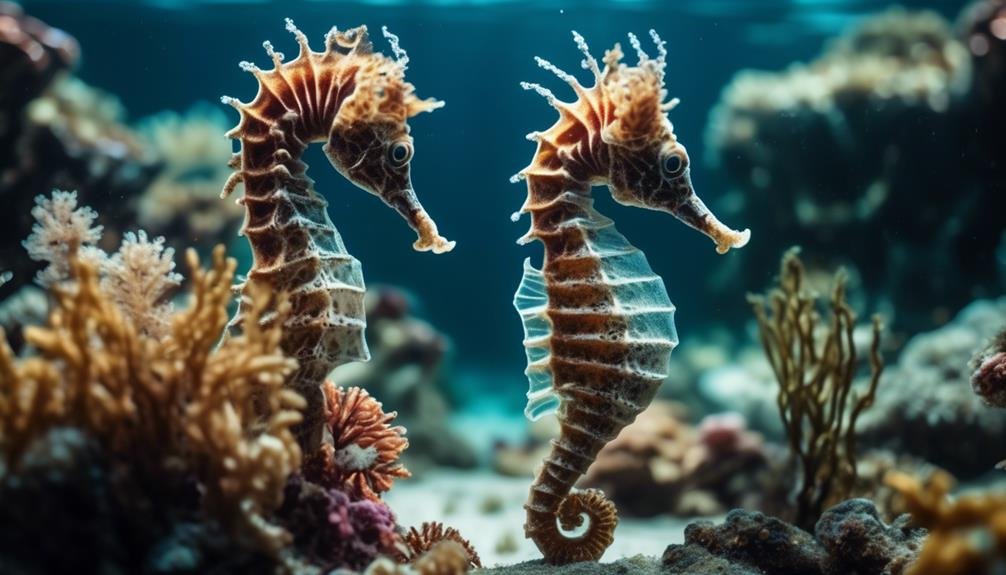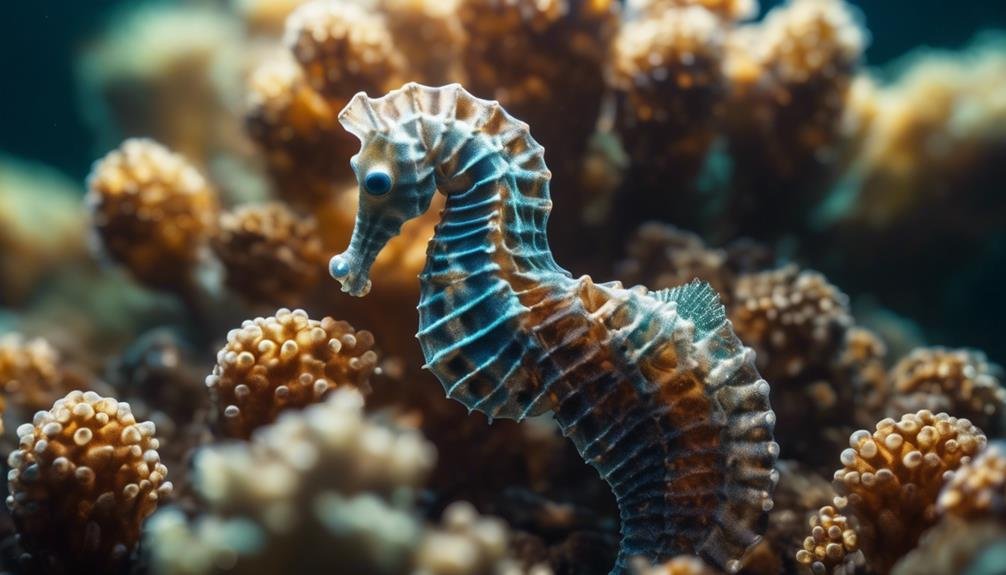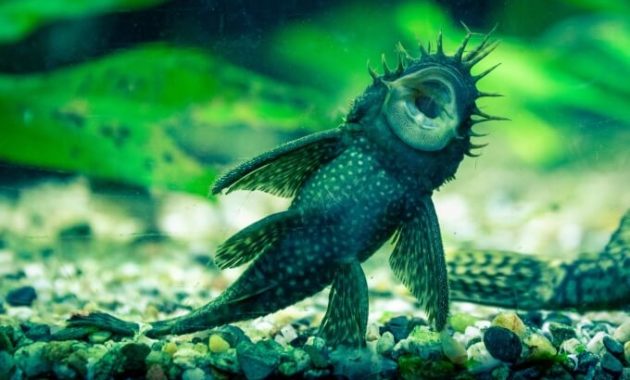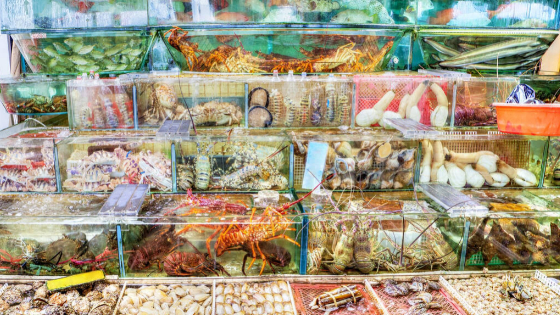
Welcome to the enchanting realm of seahorses, where an array of captivating secrets awaits your discovery.
In this exploration, you will embark on a journey to unravel the mysteries and marvels of these exquisite creatures.
As you dive into their origins, you will uncover the secrets of their care and maintenance.
Witness the astonishing wonders of their unique reproduction process.
But that’s not all – prepare to be mesmerized by the diverse range of seahorse species.
Each species has its own captivating allure.
So, get ready to immerse yourself in the underwater wonderland of seahorses.
Every mystery holds the promise of an extraordinary revelation.
Key Takeaways
- Seahorses have adapted bodies and behaviors to help them blend in with their surroundings, such as their ability to camouflage themselves and their unique mating behavior where males become pregnant and give birth to young.
- Seahorses are vulnerable to habitat loss, pollution, and overfishing, highlighting the need for conservation efforts to protect their populations.
- Proper seahorse care includes providing a suitable habitat with open swimming spaces, slow water currents, and anchoring spots like plants and corals.
- Feeding seahorses a varied diet of live and frozen foods is important to prevent nutritional deficiencies and keep their diet interesting.
Seahorse Origins: A Global Distribution
Seahorses have a global distribution, inhabiting tropical, sub-tropical, and temperate regions of most of the world’s oceans. They can be found in various parts of the world, from the warm waters of the Caribbean to the cooler seas of the Pacific.
These unique creatures are found in diverse habitats, such as coral reefs, seagrass beds, and mangrove forests. Seahorses are well adapted to their surroundings, with their slender bodies and prehensile tails allowing them to cling to vegetation and coral branches. Their ability to camouflage themselves also helps them blend in with their surroundings, providing them with protection from predators.
Despite their widespread distribution, seahorses are still considered to be vulnerable due to habitat loss, pollution, and overfishing. Their global presence serves as a reminder of the beauty and fragility of our oceans.
Seahorse Maintenance and Care: Creating the Perfect Habitat

To ensure the well-being of your seahorses, it’s crucial to create the perfect habitat through thoughtful maintenance and care.
Seahorses should be housed in aquariums that provide large open swimming spaces and sufficient depth.
Slow water currents are ideal for seahorse tanks, as they prefer gentle movement.
It’s important to provide plenty of anchoring spots in the tank, such as live or plastic plants and corals with thin branches, as seahorses like to hold onto objects with their tails.
Keeping seahorses in a species-specific tank or with pipefish is recommended, as they thrive in compatible company.
Additionally, seahorses are sensitive to rapid changes in water parameters, so it’s important to maintain stable conditions.
Feeding Seahorses: From Live Foods to Frozen Delights

After setting up the perfect habitat for your seahorses, it’s important to understand their dietary needs, ranging from live foods to frozen delights. Here are three key points about feeding seahorses that will help you keep them happy and healthy:
- Live Foods: Wild-caught seahorses may only accept live foods. Their natural diet consists of small crustaceans, such as brine shrimp and mysis shrimp. Providing live foods will ensure that they receive the necessary nutrients and stimulation to thrive.
- Frozen Delights: Tank-bred seahorses readily accept frozen foods like mysis shrimp and frozen brine shrimp. These convenient and nutritious options are easy to store and feed to your seahorses. Just make sure to thaw the frozen food before offering it to them.
- Variety is Key: Offering a variety of live and frozen foods will help prevent nutritional deficiencies and keep your seahorses engaged during feeding time. Experiment with different options like copepods, daphnia, and even small pieces of fish or shrimp to keep their diet interesting.
The Fascinating World of Seahorse Breeding

Witness the incredible process of seahorse reproduction, a captivating journey that showcases the unique and intricate nature of these mesmerizing creatures.
Seahorses have a fascinating breeding strategy that sets them apart from other marine species. Unlike most animals, it’s the male seahorse that becomes pregnant and gives birth to the young.
The female seahorse deposits her eggs into the male’s brood pouch, where they’re fertilized and carried until they hatch. This brood pouch provides a safe environment for the developing embryos, offering them protection and nourishment.
Once the eggs hatch, the male seahorse goes through a process of muscular contractions to expel the fully-formed fry into the water. Unfortunately, the survival rates of seahorse spawns in home aquariums are low due to the small size of the fry.
Nonetheless, witnessing the intricacies of seahorse breeding is a truly remarkable experience.
Exploring the Diverse Aquarium Varieties of Seahorses

As we continue our exploration of seahorses, let’s now dive into the fascinating world of the diverse aquarium varieties these captivating creatures come in.
- Black Seahorse: With its striking dark coloration, the black seahorse adds an air of mystery to any aquarium. Its unique appearance is sure to captivate and intrigue.
- Dwarf Seahorse: Small in size but big in charm, the dwarf seahorse is perfect for those with limited space. Its delicate features and graceful movements make it a delightful addition to any aquarium.
- Ingens Seahorse: Known for its impressive size, the ingens seahorse commands attention with its majestic presence. Watching this magnificent creature glide through the water is truly awe-inspiring.
These aquarium varieties offer a range of sizes, colors, and characteristics, allowing enthusiasts to create their own underwater wonderland. Whether you prefer the elegance of the black seahorse, the charm of the dwarf seahorse, or the grandeur of the ingens seahorse, each variety brings its own unique beauty to the world of seahorses.
Unveiling the Enigmatic Nature of Seahorse Behavior

Seahorse behavior, often characterized as mysterious and elusive, continues to fascinate researchers and aquarium enthusiasts alike. These intriguing creatures have a unique set of behaviors that make them stand out in the underwater world.
One of the most fascinating aspects of seahorse behavior is their mating rituals. Unlike most other animals, it’s the male seahorse that carries the eggs and gives birth to the young. This behavior is rare in the animal kingdom and has puzzled scientists for years.
Seahorses also exhibit a remarkable ability to change color and blend in with their surroundings. This adaptive behavior helps them hide from predators and ambush their prey.
Additionally, seahorses are known for their slow and graceful movements, making them a sight to behold in aquariums.
Despite ongoing research, there’s still much to learn about the enigmatic nature of seahorse behavior.
Frequently Asked Questions
Are Seahorses Aggressive Towards Other Fish in the Aquarium?
Seahorses are non-aggressive towards other fish in the aquarium. They prefer large open swimming spaces, slow water currents, and tank mates like pipefish. Keep in mind that they are sensitive to water changes and easily stressed.
Can Seahorses Survive in Freshwater Aquariums?
No, seahorses cannot survive in freshwater aquariums. They are saltwater creatures and require specific conditions to thrive. Keeping them in freshwater can lead to stress and health issues. Stick to a saltwater setup for their well-being.
How Long Do Seahorses Live in Captivity?
Seahorses typically live 2-5 years in captivity. Providing a proper environment, like a large aquarium with open swimming spaces and slow water currents, along with feeding them a suitable diet, can help extend their lifespan.
Can Seahorses Change Their Color to Blend With Their Surroundings?
Yes, seahorses can change their color to blend with their surroundings. This ability, called camouflage, helps them hide from predators and makes them better suited to their environment.
Do Seahorses Have Any Natural Predators in the Ocean?
Yes, seahorses have natural predators in the ocean. They are preyed upon by larger fish, such as tuna, rays, and some species of sharks. Seahorses rely on their camouflage and hiding abilities to avoid being eaten.
What similarities do Seahorses and Dragonets share in their underwater habitats and behaviors?
Seahorses and exquisite sea dragonets both thrive in shallow, tropical waters, often hiding in seagrass beds, coral reefs, or mangroves. Known for their delicate, intricate movements, both species use their slender bodies and unique appendages to navigate their underwater environments with grace and precision.
Conclusion
So, now you have ventured into the underwater wonderland of seahorses, uncovering their origins, learning about their care, feeding habits, and even their unique breeding process.
You have been introduced to the mesmerizing variety of seahorse species, each with its own enchanting characteristics.
The mysteries of seahorses have been unveiled, leaving you in awe of these captivating creatures and the magical world they inhabit.
As you resurface from this extraordinary journey, you carry with you a deeper appreciation for the wonders of the underwater realm.




